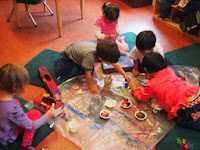 |
| Observing the water |
I began group time with an experiment with the children today. I filled a bowl with water and asked the children to observe. I struck the side of the bowl and here are their observations:
Molly: I see waves.
Allye: The water jumps out.
Alfie: I hear "ding".
 |
| Different ways to pluck the elastic |
I told them the tiny waves they see are called vibrations. Below is our conversation to connect vibrations to sounds:
No movement from water.
Mary: Can you hear a "ding" now?
Children: No.
I hit the side of the bowl.
Children: I hear "ding"!
Mary: Do you see the vibrations too?
Children: Yes!
Mary: Now look closely and see what you notice about the vibrations and the "ding" at the same time.
I hit the side of the bowl again.
Alfie: There's waves when the ding starts!
Molly: And when the ding goes away the vibration disappear!
 |
| Feeling the vibrations |
I love it the way they collaborate together to get a conclusion! I explained further that sound is produced through vibrations.
The children checked their understanding with elastic bands and a jumping macaroni game. The group was very creative in finding ways to produce sounds and vibrations with the elastic bands. The children had a blast when they tried to make the macaroni jump off the drum through vibrations.


 Experimenting rhythms with the tone bars has guided us into our next concept: form. What are a few forms of folk song games? We sang the song "Bumpety, Bumpety, Yellow Bus" and the children were especially interested in the syllables that make up their names. We dotted the syllables on paper. I could see from the concentration on their faces that they were linking the syllables they hear to the dots. To help us see the song, we drew a song map.
Experimenting rhythms with the tone bars has guided us into our next concept: form. What are a few forms of folk song games? We sang the song "Bumpety, Bumpety, Yellow Bus" and the children were especially interested in the syllables that make up their names. We dotted the syllables on paper. I could see from the concentration on their faces that they were linking the syllables they hear to the dots. To help us see the song, we drew a song map.





















